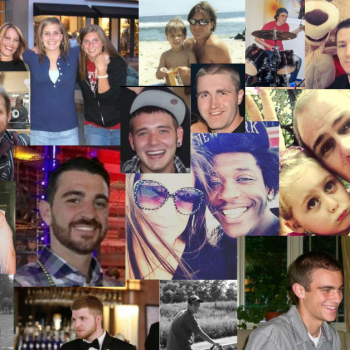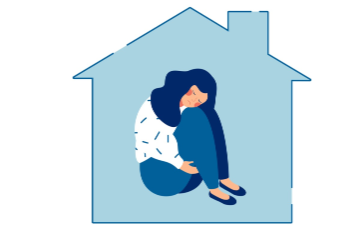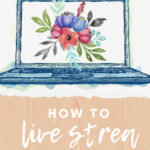How to Live-Stream a Funeral or Memorial Service
/ Memorials and Remembrance : Eleanor Haley
With travel severely curtailed and nearly all gatherings restricted, arguably one of the most negatively impacted aspects of this public health emergency is the expounding grief for friends and family members who do not have the ability to travel for bereavement and memorial services.
On March 16, 2020, The Centers for Disease Control held a conference call with key stakeholders within the bereavement community, including National Funeral Directors Association, and reiterated the importance of limiting any gatherings to under fifty people, as well as a strong recommendation to live webcast funeral and memorial services so that loved ones can say goodbye without attending in-person.
Obviously, this got our attention. We received emails and social media comments about how hard it is to experience crushing loss when people cannot physically come together with loved ones. Though grief is often a lonely road, the gathering of friends is one of the few sources of comfort.
Funerals and memorials remind us we aren’t alone in this loss. They allow us to look around at all the lives touched; to share the memories and stories that will be a small light in the dark days ahead. Funerals give us a time not just to reflect the life lost, but also of the legacy that remains. And for some people, funerals are what makes the loss finally feel real.
What makes the current situation even more complicated is that the proposed alternative—to live webcast funerals—is unchartered territory for many people and professionals alike. What does it even mean to live webcast a funeral? There are questions of logistics and technology. And there is the question of whether a webcast could really capture what we are losing by not being together in-person.
We want to try and help navigate this situation. But in order to do so, we need to answer some of our own questions about webcasting funerals. We started by hitting up our friend Tim Treanor of OVS Media. OVS Media was one of the first companies to specialize in the live internet broadcasting of government and non-profit content... They've worked with everyone from Marriott to NASA to the CDC.
By the time Tim and I talked about this last week, his wheels were already turning. He was quick to explain that live internet broadcasting has emerged as a mission-critical platform for global communications during this time of mandatory quarantine, but that he and his team agree that "One of the most important things to explore is that funeral and memorial services need to start being webcast live".
See, he's a grief-friend for a reason. Tim and his team are actually busy making the case for the government providing large-scale funding for these services, which would be pretty fantastic. But, knowing the government has a lot on their plate at the moment and that people are in need of help now, he graciously agreed to share some of his expertise with the WYG community. So, read our interview with Tim below!
Our first question is more of an observation. In reading comments on our Facebook page, we were heartened to see incredible stories of about technology. It is clearly bringing some people together for funerals and memorials. Unfortunately, we also saw difficulties and frustrations.
One of our readers shared this of a friend's funeral: "His funeral was broadcast online, but the person who shared it forgot to share the password, leaving people unable to tune in."
Though many are familiar with FaceTime, Skype, Facebook Live, and Zoom, I imagine a lot is left to chance or missed when families set up streaming on their own. What are some of the common problems or technical issues you see when people set this up on their own?
"To start with, I think we have to sort of define what we’re referring to as 'webcasting' versus some of the other technologies out there," Tim said from his office in Washington, DC.
"Apps like FaceTime are great for having a conversation with a single person, and things like Google Hangouts are better for maybe up to a dozen people. For up to twenty-five or so, Zoom and a few of the so-called 'webinar' services can work well, but really if you’re going to have more than say twenty-five people or more watching live and participating in the ceremony, then you need to start looking for a professional with live internet broadcasting experience."
Another reader shared: "The funeral of a dear friend was invitation-only in order to comply with maximum allowed at a gathering. It was also live-streamed. Watching from home was okay insofar as seeing the tribute. It was lacking in the opportunity to connect with others and share stories and memories".
For most families who are streaming, I imagine this can feel like a bit of a one-way broadcast, not allowing for direct connection or storytelling. Do you think this is an unavoidable limitation of creating virtual funerals, or as a professional in the field do you see ways to create more connections?
"There is no substitute for being with others physically to share in grief," Tim said, "and it would be wrong-headed to promote webcasting or any other remote service as a kind of replacement, but by live-streaming the eulogies and other elements of the funerary service, we hope that we can help convey a real-time sense of comfort, and a way to acknowledge the passing of a loved one, and by extension perhaps a sense of closure.
So it’s not a substitute to attending in person–rather at its best, it's an effective platform to gather the friends and families and other stakeholders to convene in a live television experience for those who are geographically dispersed or unable to attend in-person given the current conditions."
We were so touched to read the experience of one family, who found new ways to connect. They shared: “We held our grandma’s funeral through a Zoom meeting. Just her 4 children and their spouses could be at the mortuary for the service, but all the grandkids and their families were online. We were able to participate by singing together (although not all in tune!). Some cousins gave prayers and played the piano virtually. It was a difficult time to try to plan a funeral, but I’m glad we were still able to do it and honor her good long life. At the graveside, we used FaceTime to participate in the dedication of the grave. While none of this was ideal, I am grateful for the technology that allowed us to 'be together' despite the circumstances around us.”
Clearly families are already getting incredibly creative and finding ways to create that sense of connection, despite challenges. To families considering a virtual funeral (or the social workers and funeral directors helping them), what are your biggest pieces of advice or creative tips?
"A live webcast won’t be nearly as comforting as a being in-person and onsite, but it can still be a great way to celebrate the life of someone dear to us in our own ways. Our biggest advice is to remember ‘live is live’ and live internet broadcasting has dozens of points of possible failure along the way that can make any event go sideways technically.
You need to make sure the technical aspects of the live webcast have been walked through first, before the event if possible, to minimize points of failure and reduce the technical risks. There is nothing more stressful during a live event than experiencing real-time technical difficulties. Nobody wants to be installing drivers or dealing with audio issues or bandwidth constraints or the myriad of other technical problems during the actual memorial service."
If someone want to reach out to OSV directly, whether it be to help with advocacy around funding funerals or to look into streaming for funeral homes, churches, or families, where can they find you?
"To learn more about live internet broadcasting, please visit us at www.ovsmedia.com. We can also be reached at info@ovsmedia.com and (202) 509-9795. We hope we can be of service to those who are experiencing loss. And hopefully, someday live internet broadcasting will be a commonplace platform for people to share and comfort during a time of grief."
Subscribe to receive posts straight to your email inbox.
We wrote a book!
After writing online articles for What’s Your Grief
for over a decade, we finally wrote a tangible,
real-life book!
What’s Your Grief? Lists to Help you Through Any Loss is for people experiencing any type of loss. This book discusses some of the most common grief experiences and breaks down psychological concepts to help you understand your thoughts and emotions. It also shares useful coping tools, and helps the reader reflect on their unique relationship with grief and loss.
You can find What’s Your Grief? Lists to Help you Through Any Loss wherever you buy books:






Bella July 6, 2022 at 12:17 am
We are looking for a streaming company to help us with the live streaming project; I’m glad I came across this article and learned things to consider in live streaming a funeral.
I like how you mentioned the importance of having to stream the funeral, especially in the situation we are in right now.
I will share this with my husband and see how this can help us decide who and when to contact a streaming company to assist us.
link removed per site guidelines
Taylor Hansen September 2, 2020 at 11:52 am
It’s interesting that a live webcast of a funeral can be a good way to celebrate the life of a loved one. My uncle just passed away last night due to cancer and we’re thinking of having his funeral broadcasted to accommodate the pandemic. We’ll be sure to check the options for funeral homes to make it a good memorial for him. (no links)
Laura Higgins March 29, 2020 at 12:55 pm
To continue my comment –
Meeting in person is the ideal, however when we can’t online ceremonies will bridge the gap until the day we can gather in person. When the restrictions on gathering are lifted we can have another event in their memory: a ceremony, a meal, a hike, a charity fundraiser, a walk in memory, an open house or reception. It can even be on their birthday or death anniversary. I’ve worked with families that had another ceremony of remembrance 1 year after the death and in one case on the 10th anniversary of the death and they were very meaningful.
My heart goes out to you all and I’m thinking of you at this difficult time.
Laura Higgins March 29, 2020 at 12:52 pm
I’m a Life-Cycle Celebrant in Ontario and I’ve given this some thought already, having already worked with families who have loved ones attend memorial services through Skype because they couldn’t attend in person. In some cases , the person attending by Skype was one of those giving a eulogy or singing a song in tribute of the person who died. There are so many possibilities! With Zoom you have the option of screen-sharing where the zoom host can play a video montage of photos – a slide show – that everyone online can watch as part of the ceremony. Asking everyone to submit photos in advance to include in this can add to their sense of participation.
When writing a ceremony for a celebration of life or memorial I’ve also worked with family members remotely when I can’t meet in person to get their memories and stories to include in the ceremony – we communicate by email or phone. This, again, is a way for people to feel included when they hear me sharing something they’ve contributed.
Families in smaller groups can set up times to connect right after the online ceremony is over, where through facebook messenger, google hangouts or zoom, they can bring some food to eat while conversing through video
When the invitation to the livestreamed ceremony is sent out, it can include instructions for connecting, any items with which they can participate at home (eg. have a candle ready to light during the ceremony) and also how to receive a recording of the ceremony after in case they can’t participate in real time.
It will never be the same as being together in person, I know. However, having something – anything – now to honour our loved ones will help bridge the gap until we CAN gather together in the same place. When you are able to gather again – another event can take place whether that’s another ceremony, a reception, open house, a meal or picnic, a charity event, a hike, or another form of tribute on their birthday or the anniversary of their death or whatever day and time feels right.
Laura Higgins March 29, 2020 at 12:42 pm
I’m a Life-Cycle Celebrant in Ontario and I’ve given this some thought already, having already worked with families who have loved ones attend memorial services through Skype because they couldn’t attend in person. In some cases , the person attending by Skype was one of those giving a eulogy or singing a song in tribute of the person who died. There are so many possibilities! With Zoom you have the option of screen-sharing where the zoom host can play a video montage of photos – a slide show – that everyone online can watch as part of the ceremony. Asking everyone to submit photos in advance to include in this can add to their sense of participation.
When writing a ceremony for a celebration of life or memorial I’ve also worked with family members remotely when I can’t meet in person to get their memories and stories to include in the ceremony – we communicate by email or phone. This, again, is a way for people to feel included when they hear me sharing something they’ve contributed.
Families in smaller groups can set up times to connect right after the online ceremony is over, where through facebook messenger, google hangouts or zoom, they can bring some food to eat while conversing through video
When the invitation to the livestreamed ceremony is sent out, it can include instructions for connecting, any items with which they can participate at home (eg. have a candle ready to light during the ceremony) and also how to receive a recording of the ceremony after in case they can’t participate in real time.